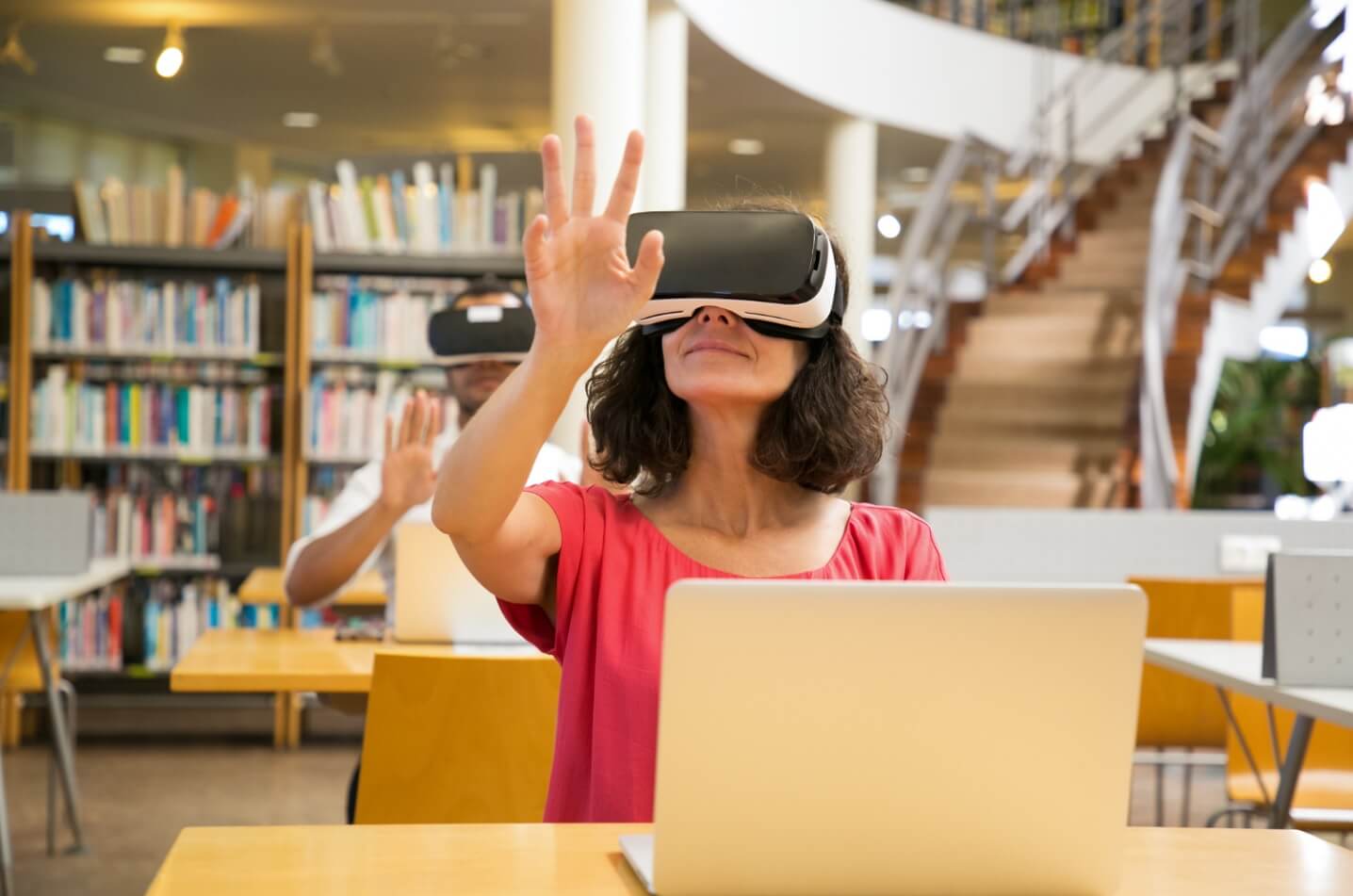Ever put on a pair of goggles and emerged into a whole new environment? If it sounds familiar, you’ve probably experienced Virtual Reality’s (VR) at its best. But VR is more than just a toy for gamers; it’s a breakthrough technology that’s causing a stir in a variety of industries. And what’s more? VR technology is also starting to be used in education.

So, what’s VR exactly? Imagine being able to dive headfirst into a digitally constructed environment that feels oh-so-real. That’s VR for you – it offers a 360-degree immersive experience that takes you miles away while you’re still snug in your living room.
But in schools? Yep! The whiteboard days are evolving. With VR, classrooms are not just confined to four walls. From trekking through the Amazon rainforest without leaving the school premises to exploring the mysteries of the universe, VR is propelling education into a dimension we once only dreamt about. Let’s gear up and see how!
Benefits of VR in education
In a world where VR is dominating modern education, there are a magnitude of benefits for using this technology in your classroom.
Beyond just the “cool factor”, VR offers an unmatched immersive experience, turning abstract concepts into tangible, interactive realities. Think about the spark in a student’s eyes as they virtually stroll through ancient civilizations or dive deep into a cell’s nucleus. It’s not just about visualizing; it’s about experiencing.
With VR, boundaries blur between the theoretical and the practical. Learning becomes a dynamic journey, tailored to engage multiple senses, and cater to various learning styles.
Increased engagement and motivation
The traditional classroom setup can sometimes be, well, a bit snooze worthy. Enter VR. With its dynamic and immersive nature, learning becomes this epic adventure, and not just a mundane task. When a subject is presented in a VR format, students aren’t just passively listening; they’re living the lesson. It’s no wonder they’re more invested, eager, and stoked about diving into new topics.
Improved learning outcomes
Studies have been dropping some truth bombs lately – students using VR show better retention rates. Why? Because VR isn’t just learning; it’s an experience. This immersive kind of learning makes complex topics easier to grasp. You’re not just hearing or reading about a concept; you’re literally surrounded by it.
Enhanced creativity and problem-solving skills
Think of VR as this massive, open sandbox. In this space, students are free to explore, experiment, and challenge their own perspectives. It’s not just about consuming information but also innovating. Collaborative VR tasks? They’re like escape rooms, where everyone’s brainstorming and pooling their ideas to solve problems. Think team building but on the extreme level.
Development of empathy and social skills
If you have ever wished to truly understand someone else’s life? VR scenarios let students do just that. They can “walk in someone else’s shoes”, experiencing different cultures, histories, and life challenges. This digital empathy trip can cultivate deeper understanding and human connections.
Overcoming learning barriers
One size doesn’t fit all, especially in education. VR is like this chameleon, adapting to individual student needs. Whether it’s catering to different learning styles or providing inclusive education opportunities for those with disabilities, VR is breaking down barriers and leveling the educational playing field. Everyone gets a VIP seat in the VR classroom.
Where can you use VR in your class?
After reading what you have so far, we bet you have a burning question. Well, how can I use this in my classroom with the subjects I teach? Let’s explore that for you now.
Science
You know what’s cooler than reading about the rainforest? Virtually trekking through it. With VR, students can embark on epic journeys: from wandering the dense Amazonian canopies, to floating through the bloodstream, or even setting foot on Mars. Science class becomes this captivating voyage, offering insights that a textbook just can’t match.
History
Forget memorizing dates; VR lets students live them. Imagine standing among the crowds during Martin Luther King Jr.’s iconic speech or strolling through the bustling streets of ancient Rome. VR gives history the breath of life, turning dusty events into vivid, unforgettable experiences. It’s time-travel without the time machine.
Language learning
Immersing oneself in a foreign country is the best way to learn its language. VR does just that but minus the jet lag. Take a break into a Parisian café or a Tokyo market; with VR, students are surrounded by native speakers, local culture, and all those tricky slang words, boosting fluency like never before.
Math and engineering
Abstract math problems? Not anymore! VR visualizes complex equations and concepts through 3D modeling and simulations. Suddenly, calculus feels less intimidating, and engineering designs are interactive playgrounds. It’s math and engineering in HD clarity.
Art and design
Picasso would be jealous. In VR, artists aren’t limited to a canvas. They can sculpt in mid-air, paint in 3D space, and explore myriad artistic styles from Renaissance to abstract. For budding designers, VR is like a limitless studio where the imagination runs wild and free.
Challenges of VR in education
Whilst using VR In Education reaps its benefits, like everything there are some challenges that come with it.
Cost of VR equipment
Unfortunately, getting VR into every classroom isn’t cheap. That awesome gear requires a chunk of change, making the initial investment a tad hefty for most schools. However, there’s hope. More tech companies are recognizing the potential and offering grants or budget-friendly packages tailored for education.
Technical issues
Ever been in the zone and suddenly, poof, everything freezes? Classic VR. Technical glitches, software bugs, and the never-ending software updates can make the VR experience less “wow” and more “ugh”. Schools diving into the VR world need a solid IT crew on standby for these techno hiccups.
Lack of VR content
Here’s the current situation: there’s a drought in the educational VR content department. While VR games are popping up left and right, educational modules? Not so much. The challenge? Rallying more developers to create engaging, curriculum-friendly VR content. Educational tech wizards, it’s your time to shine!
Safety concerns
Like everything cool, VR comes with small print. There’s the dreaded motion sickness or the debates on how much screen time is too much. It’s crucial for schools to have guidelines – think short, regular breaks and calibrated equipment – to ensure that the VR experience remains beneficial without the queasy aftermath. Safety first, always!
Conclusion: The future of VR in education
As we’ve seen, VR isn’t just the cool new kid on the tech block; it’s a game-changer for education. From making lessons come alive to bridging learning gaps, VR is taking education on a futuristic joyride. While the journey has its bumps, from cost to tech glitches, the potential is undeniable.
Imagine a world where classrooms aren’t bound by physical limitations. Where learning is tailored to each student, and where lessons resonate on a deeply personal level. That’s the future we’re zooming towards, and VR is driving the bus.
With continual advancements in VR tech, we can expect even more immersive, interactive, and inclusive educational tools. It’s an exciting era for educators and students alike!
In a nutshell? VR is more than just tech – it’s a revolution. And as with any revolution, it’s bound to reshape landscapes. Buckle up because the classroom of tomorrow is going to be nothing short of extraordinary.
